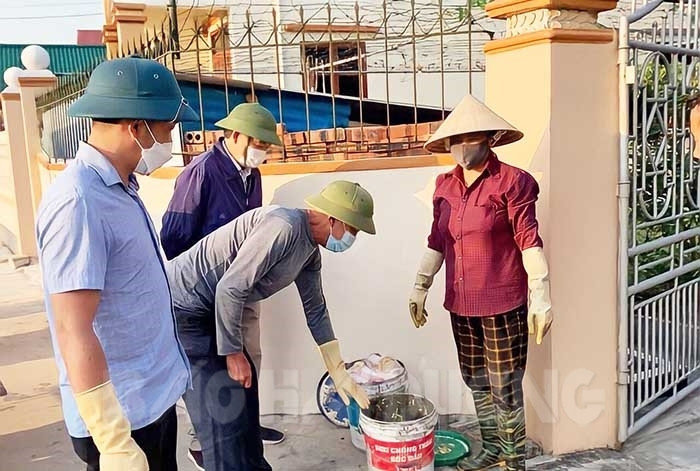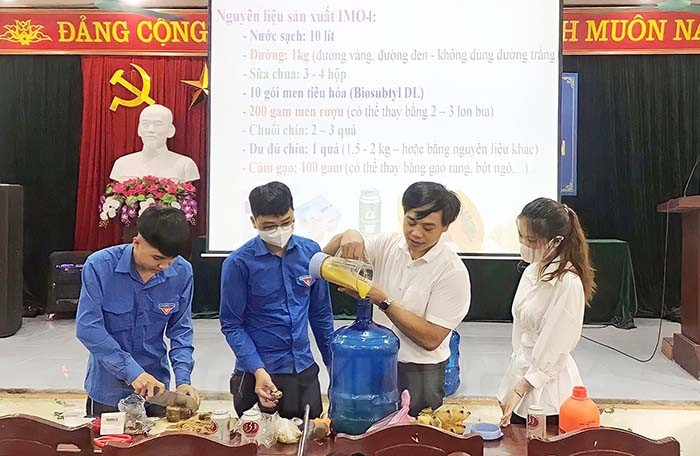These days, walking along the roads and streets in Nam Sach district, it is easy to see each family having 2 trash bins printed with the words "inorganic waste" and "organic waste" for source classification.

Propaganda and guidance on waste treatment at source are carried out to every family.
This is one of the initial results when Nam Sach resolutely implemented Resolution No. 13-NQ/HU dated March 22, 2022 of the Standing Committee of the District Party Committee.
Closing landfills
In 2021, Nam Sach district had 15 concentrated waste dumps of communes and towns and 53 waste dumps of villages and residential areas. The waste collection rate in rural areas reached over 97%, and in urban areas it reached 95%. However, these dumps were over 70% full, manual treatment methods caused environmental pollution and were no longer suitable. In order to have a sustainable solution, the Standing Committee of Nam Sach District Party Committee issued Resolution No. 13 on the implementation of classification, collection and treatment of domestic solid waste. The district chose increasing the rate of waste classification at source to contribute to ensuring environmental sanitation in the area as the breakthrough work of the year.
The entire district political system is strongly determined to join the people in implementing this resolution. Party committees at all levels, authorities, heads of agencies, units, and localities have identified the classification, collection, and treatment of domestic solid waste as a task that needs to be focused on regularly and long-term. The work of ensuring environmental sanitation, including the classification, collection, and treatment of domestic solid waste, has become an indicator for evaluating the emulation of cadres in agencies and units and a criterion for awarding the title of cultural family and cultural standard unit. The Standing Committee of the Nam Sach District Party Committee directs the monthly activities of Party committees and Party cells in grassroots Party organizations to be associated with the assessment and review of the work of classification, collection, and treatment of domestic solid waste. The Steering Committee for the implementation of the resolution was established, headed by the Secretary of the District Party Committee.
Identifying propaganda to raise people's awareness of waste classification at source as an important step, the district has innovated the content and diversified the forms of propaganda. The mass mobilization bloc, the Vietnam Fatherland Front Committee and socio-political organizations closely coordinated in propaganda work. Many thematic conferences, performances, skits, etc. were organized. Schools at all levels also organized propaganda activities to raise awareness of waste classification for students. Thousands of billboards, posters, propaganda paintings and handbooks on waste classification knowledge were hung in public places and distributed to each household. The district's electronic information portal established a specialized page to propagate the implementation of Resolution No. 13.
The district has a mechanism to reward exemplary individuals and organizations and to handle cases of non-separation. Families who do not classify their waste or do not do so thoroughly will be named three times on the loudspeaker. If they do not correct the situation, their waste collection will be stopped.
The Party Committees and authorities of communes and towns actively participated in implementing many synchronous measures. Many organizations went to each family to guide and mobilize people to classify waste at source, sprayed letters on 2 waste classification bins for people...

The Vietnam Fatherland Front Committee and socio-political organizations of Nam Sach district have many activities to propagate and guide waste classification at source.
Harvest "sweet fruit"
After nearly a month of implementing waste classification at source from May 1, Nam Sach district has reaped the first "sweet fruits". The centralized landfills were closed from May 1. Localities have organized to level and bury waste at the centralized landfills to plant grass and trees, the progress of treatment up to May 24 reached about 50%. Previously, 57 compost tanks were built with solid concrete, initially operating effectively. Organic waste was transferred to the compost tanks, inorganic waste was transferred to the waste treatment plant in Viet Hong commune (Thanh Ha).
"Now, every household classifies waste at source. Since applying this method, the amount of waste my family releases into the environment has decreased by 80%, and the vegetables in the garden are much greener thanks to the organic fertilizer from household waste," said Mr. Nguyen Danh Nam in An Doai village, An Binh commune (Nam Sach).
From May 1-24, the entire Nam Sach district had nearly 108 tons of inorganic waste transported for treatment, a significant decrease compared to before waste was classified at source.
PHAM TUYET